Operations Management: Inventory, EOQ, and Cost Analysis Report
VerifiedAdded on 2020/05/11
|13
|3081
|61
Report
AI Summary
This report delves into the core concepts of operations management, particularly focusing on inventory control and the Economic Order Quantity (EOQ) model. The report begins with an essay exploring the application of operations management principles, such as inventory management, within a business context, using McDonald's as a case study to illustrate these principles in practice. The analysis covers various aspects, including production quality, raw material procurement, customer service, and cost management. The second part of the report critically evaluates the assumptions of the EOQ model, discussing its realism and how safety stock and reorder points are incorporated. It also examines the ongoing relevance of the EOQ model in modern business practices, comparing it with alternative inventory ordering methods. Finally, the report addresses a financial scenario, calculating the cost of inventory, loan requirements, and optimal ordering quantities to minimize costs. The report includes calculations for annual ordering and carrying costs, emphasizing the importance of strategic inventory management for operational efficiency and financial stability.

Running head: OPERATIONS MANAGEMENT
OPERATIONS MANAGEMENT
Name of the Student
Name of the University
Author note
OPERATIONS MANAGEMENT
Name of the Student
Name of the University
Author note
Paraphrase This Document
Need a fresh take? Get an instant paraphrase of this document with our AI Paraphraser
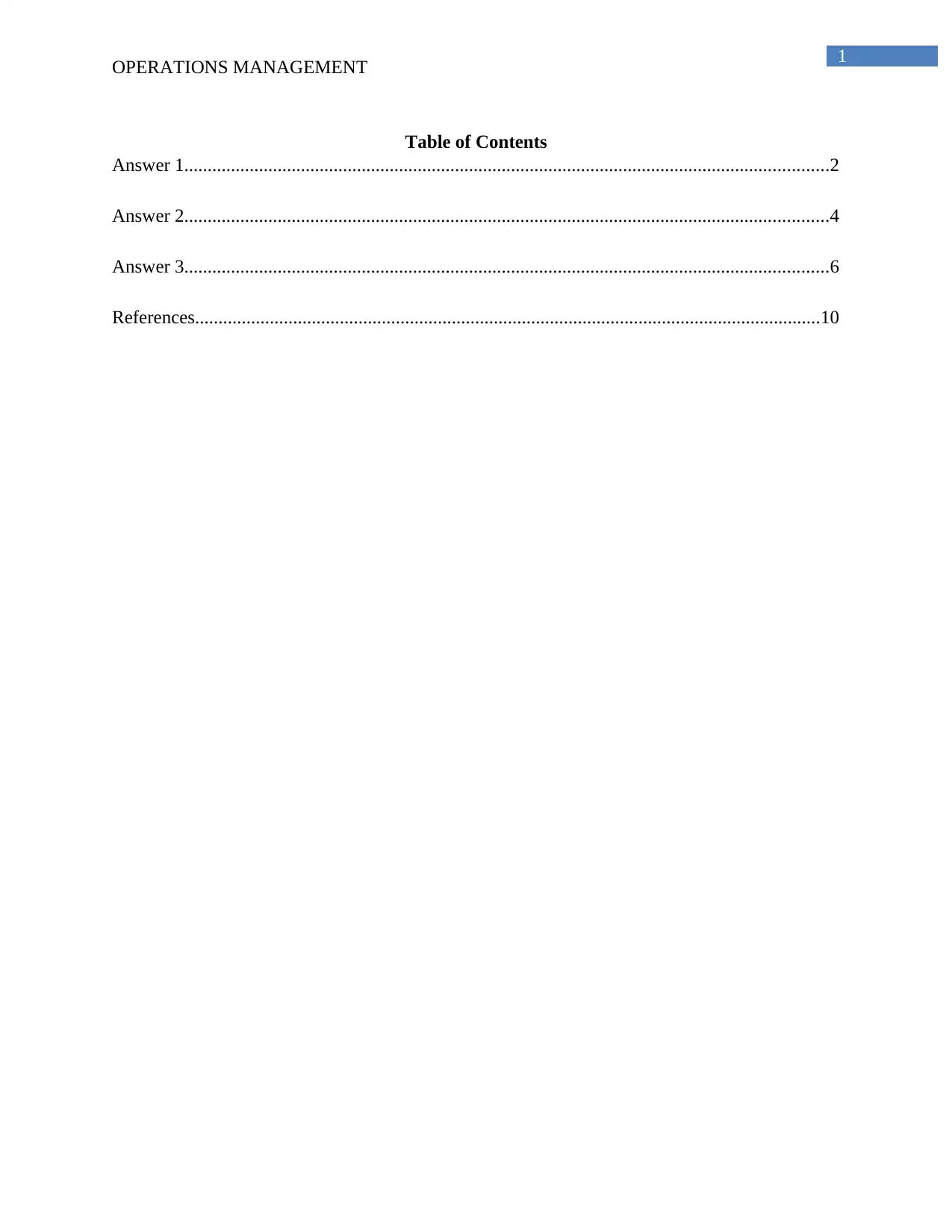
1
OPERATIONS MANAGEMENT
Table of Contents
Answer 1..........................................................................................................................................2
Answer 2..........................................................................................................................................4
Answer 3..........................................................................................................................................6
References......................................................................................................................................10
OPERATIONS MANAGEMENT
Table of Contents
Answer 1..........................................................................................................................................2
Answer 2..........................................................................................................................................4
Answer 3..........................................................................................................................................6
References......................................................................................................................................10

2
OPERATIONS MANAGEMENT
Question 1
You are to write an essay about your research into an operations concept and its application
to a business situation. The aim of the essay is to explain to an intelligent person, with no
specialised knowledge of operations management, the concept on which your research was
based and the extent of its application to the operations tasks in a manufacturing or service
organisation.
Answer 1
The concept of operation management is associated with the management of the core
purposes in the business organization who has related products and services. It is also related
with designing and control of the production processes and this will also help in redesigning the
business. The operations also produce those products which manage the quality and create
different services. Moreover, operation management also covers the banking system, customers,
suppliers and using the different technologies. Operation is one of the major functions of the
organization which is associated with supply chain, human resources, marketing and finance
(Fernie & Sparks, 2014). It is necessary to manage the operations to balance the different
inventories so as to satisfy the customer demands. It is also necessary to manage the actual
demand in the market for the products and services without involving the company in
unnecessary risk and cost. It is also necessary to meet the customer demands and maintaining the
finished goods inventory will also help the company in fulfilling the demands of the customers.
It is also necessary to maintain an adequate supply and thus this will also lead to the satisfaction
of the disappointed customers. The inventory control helps in protecting the company from
fluctuations in the demand of its products (Smith, Maull & CL, 2014).
OPERATIONS MANAGEMENT
Question 1
You are to write an essay about your research into an operations concept and its application
to a business situation. The aim of the essay is to explain to an intelligent person, with no
specialised knowledge of operations management, the concept on which your research was
based and the extent of its application to the operations tasks in a manufacturing or service
organisation.
Answer 1
The concept of operation management is associated with the management of the core
purposes in the business organization who has related products and services. It is also related
with designing and control of the production processes and this will also help in redesigning the
business. The operations also produce those products which manage the quality and create
different services. Moreover, operation management also covers the banking system, customers,
suppliers and using the different technologies. Operation is one of the major functions of the
organization which is associated with supply chain, human resources, marketing and finance
(Fernie & Sparks, 2014). It is necessary to manage the operations to balance the different
inventories so as to satisfy the customer demands. It is also necessary to manage the actual
demand in the market for the products and services without involving the company in
unnecessary risk and cost. It is also necessary to meet the customer demands and maintaining the
finished goods inventory will also help the company in fulfilling the demands of the customers.
It is also necessary to maintain an adequate supply and thus this will also lead to the satisfaction
of the disappointed customers. The inventory control helps in protecting the company from
fluctuations in the demand of its products (Smith, Maull & CL, 2014).
⊘ This is a preview!⊘
Do you want full access?
Subscribe today to unlock all pages.

Trusted by 1+ million students worldwide
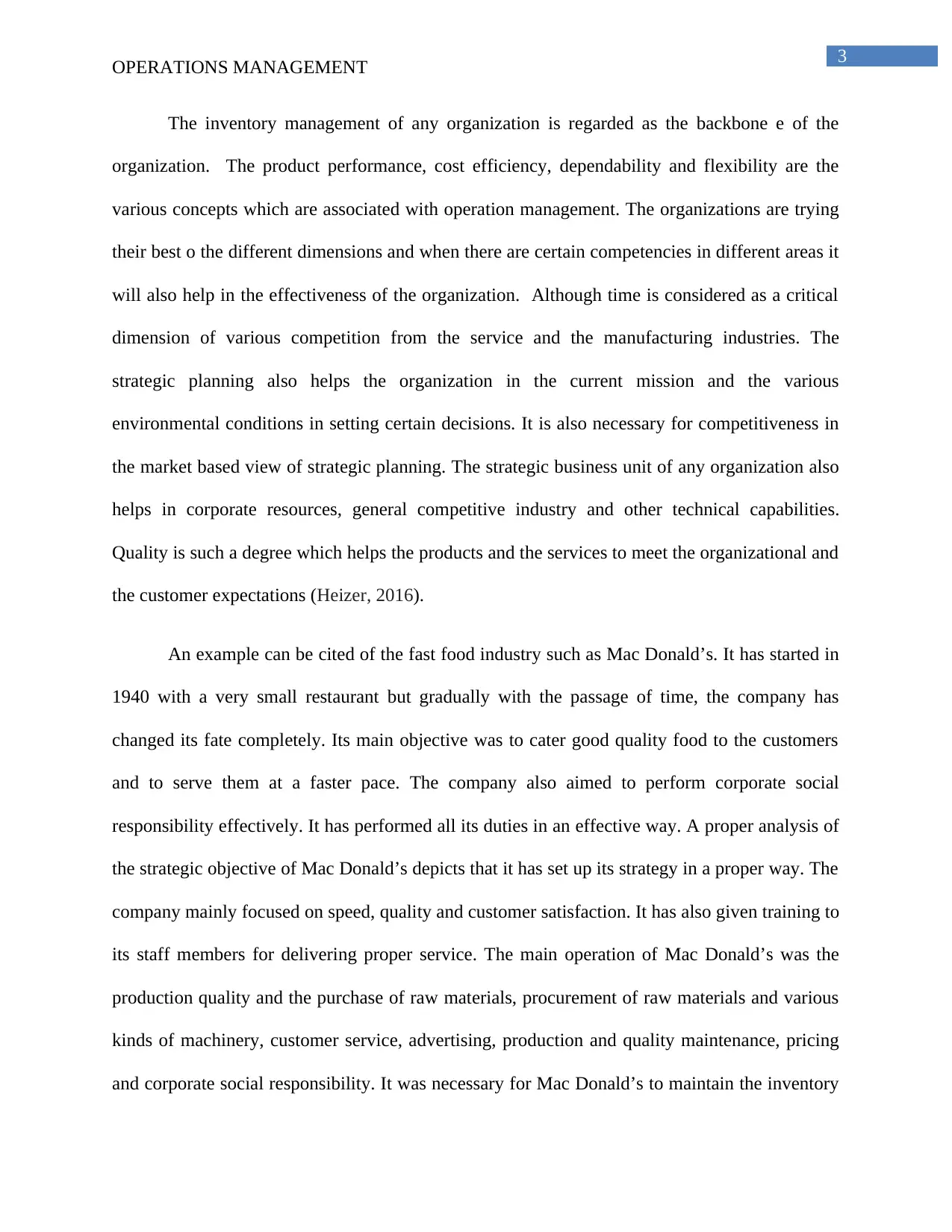
3
OPERATIONS MANAGEMENT
The inventory management of any organization is regarded as the backbone e of the
organization. The product performance, cost efficiency, dependability and flexibility are the
various concepts which are associated with operation management. The organizations are trying
their best o the different dimensions and when there are certain competencies in different areas it
will also help in the effectiveness of the organization. Although time is considered as a critical
dimension of various competition from the service and the manufacturing industries. The
strategic planning also helps the organization in the current mission and the various
environmental conditions in setting certain decisions. It is also necessary for competitiveness in
the market based view of strategic planning. The strategic business unit of any organization also
helps in corporate resources, general competitive industry and other technical capabilities.
Quality is such a degree which helps the products and the services to meet the organizational and
the customer expectations (Heizer, 2016).
An example can be cited of the fast food industry such as Mac Donald’s. It has started in
1940 with a very small restaurant but gradually with the passage of time, the company has
changed its fate completely. Its main objective was to cater good quality food to the customers
and to serve them at a faster pace. The company also aimed to perform corporate social
responsibility effectively. It has performed all its duties in an effective way. A proper analysis of
the strategic objective of Mac Donald’s depicts that it has set up its strategy in a proper way. The
company mainly focused on speed, quality and customer satisfaction. It has also given training to
its staff members for delivering proper service. The main operation of Mac Donald’s was the
production quality and the purchase of raw materials, procurement of raw materials and various
kinds of machinery, customer service, advertising, production and quality maintenance, pricing
and corporate social responsibility. It was necessary for Mac Donald’s to maintain the inventory
OPERATIONS MANAGEMENT
The inventory management of any organization is regarded as the backbone e of the
organization. The product performance, cost efficiency, dependability and flexibility are the
various concepts which are associated with operation management. The organizations are trying
their best o the different dimensions and when there are certain competencies in different areas it
will also help in the effectiveness of the organization. Although time is considered as a critical
dimension of various competition from the service and the manufacturing industries. The
strategic planning also helps the organization in the current mission and the various
environmental conditions in setting certain decisions. It is also necessary for competitiveness in
the market based view of strategic planning. The strategic business unit of any organization also
helps in corporate resources, general competitive industry and other technical capabilities.
Quality is such a degree which helps the products and the services to meet the organizational and
the customer expectations (Heizer, 2016).
An example can be cited of the fast food industry such as Mac Donald’s. It has started in
1940 with a very small restaurant but gradually with the passage of time, the company has
changed its fate completely. Its main objective was to cater good quality food to the customers
and to serve them at a faster pace. The company also aimed to perform corporate social
responsibility effectively. It has performed all its duties in an effective way. A proper analysis of
the strategic objective of Mac Donald’s depicts that it has set up its strategy in a proper way. The
company mainly focused on speed, quality and customer satisfaction. It has also given training to
its staff members for delivering proper service. The main operation of Mac Donald’s was the
production quality and the purchase of raw materials, procurement of raw materials and various
kinds of machinery, customer service, advertising, production and quality maintenance, pricing
and corporate social responsibility. It was necessary for Mac Donald’s to maintain the inventory
Paraphrase This Document
Need a fresh take? Get an instant paraphrase of this document with our AI Paraphraser
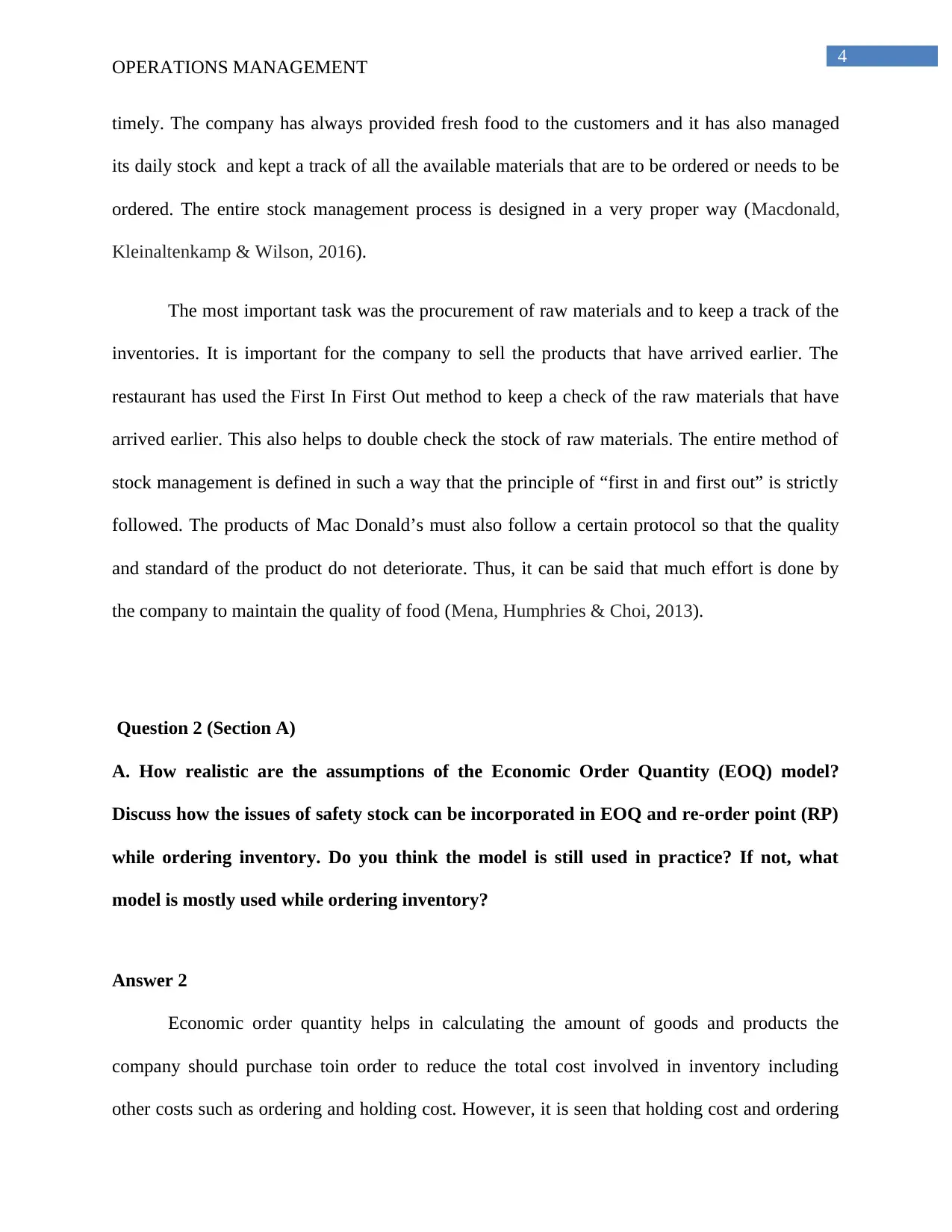
4
OPERATIONS MANAGEMENT
timely. The company has always provided fresh food to the customers and it has also managed
its daily stock and kept a track of all the available materials that are to be ordered or needs to be
ordered. The entire stock management process is designed in a very proper way (Macdonald,
Kleinaltenkamp & Wilson, 2016).
The most important task was the procurement of raw materials and to keep a track of the
inventories. It is important for the company to sell the products that have arrived earlier. The
restaurant has used the First In First Out method to keep a check of the raw materials that have
arrived earlier. This also helps to double check the stock of raw materials. The entire method of
stock management is defined in such a way that the principle of “first in and first out” is strictly
followed. The products of Mac Donald’s must also follow a certain protocol so that the quality
and standard of the product do not deteriorate. Thus, it can be said that much effort is done by
the company to maintain the quality of food (Mena, Humphries & Choi, 2013).
Question 2 (Section A)
A. How realistic are the assumptions of the Economic Order Quantity (EOQ) model?
Discuss how the issues of safety stock can be incorporated in EOQ and re-order point (RP)
while ordering inventory. Do you think the model is still used in practice? If not, what
model is mostly used while ordering inventory?
Answer 2
Economic order quantity helps in calculating the amount of goods and products the
company should purchase toin order to reduce the total cost involved in inventory including
other costs such as ordering and holding cost. However, it is seen that holding cost and ordering
OPERATIONS MANAGEMENT
timely. The company has always provided fresh food to the customers and it has also managed
its daily stock and kept a track of all the available materials that are to be ordered or needs to be
ordered. The entire stock management process is designed in a very proper way (Macdonald,
Kleinaltenkamp & Wilson, 2016).
The most important task was the procurement of raw materials and to keep a track of the
inventories. It is important for the company to sell the products that have arrived earlier. The
restaurant has used the First In First Out method to keep a check of the raw materials that have
arrived earlier. This also helps to double check the stock of raw materials. The entire method of
stock management is defined in such a way that the principle of “first in and first out” is strictly
followed. The products of Mac Donald’s must also follow a certain protocol so that the quality
and standard of the product do not deteriorate. Thus, it can be said that much effort is done by
the company to maintain the quality of food (Mena, Humphries & Choi, 2013).
Question 2 (Section A)
A. How realistic are the assumptions of the Economic Order Quantity (EOQ) model?
Discuss how the issues of safety stock can be incorporated in EOQ and re-order point (RP)
while ordering inventory. Do you think the model is still used in practice? If not, what
model is mostly used while ordering inventory?
Answer 2
Economic order quantity helps in calculating the amount of goods and products the
company should purchase toin order to reduce the total cost involved in inventory including
other costs such as ordering and holding cost. However, it is seen that holding cost and ordering

5
OPERATIONS MANAGEMENT
cost moves in opposite direction because an increase in the ordering cost will cause a decrease in
holding cost of the company (Chen, Cárdenas-Barrón & Teng, 2014). Economic Order Quantity
has number of assumptions such as
1. Demand for the model is known,
2. The lead time for the model is constant over time,
3. Ordered inventory that the company can receive at a specific time,
4. With the increase in quantity the ordering cost decreases,
5. The carrying cost of the order increases as the company increases the quantity of the
order and
6. There is no discount on any number of quantities.
These are some of the assumptions offered by the theory on the inventory control. However, the
usage of the model and its assumptions in real world is yet to be tested. Someof the assumptions
of the model do have their application in real world. For instance, the can know the amount of
cost that will increase if they increase the ordering quantity. This is the number of order because
the quantity that the company is ordering has a cost and it increases with number (Cobb&
Johnson, 2014). On the other hand, one more assumption such as the carrying cost increases with
an increase in the number of ordering quantity. It is realistic because the quantity of order needs
to be carried from one place to the other and this requires a cost. Thus, number of order and cost
are directly proportionate and is realistic. However, other assumptions such as demand are
known and the lead-time for the inventory is not real in nature. This is because the demand is
something that comes from the customers and it cannot be estimated by the company accurately
from before by the manufacturer. Thus some of the assumption of the model is unrealistic in
OPERATIONS MANAGEMENT
cost moves in opposite direction because an increase in the ordering cost will cause a decrease in
holding cost of the company (Chen, Cárdenas-Barrón & Teng, 2014). Economic Order Quantity
has number of assumptions such as
1. Demand for the model is known,
2. The lead time for the model is constant over time,
3. Ordered inventory that the company can receive at a specific time,
4. With the increase in quantity the ordering cost decreases,
5. The carrying cost of the order increases as the company increases the quantity of the
order and
6. There is no discount on any number of quantities.
These are some of the assumptions offered by the theory on the inventory control. However, the
usage of the model and its assumptions in real world is yet to be tested. Someof the assumptions
of the model do have their application in real world. For instance, the can know the amount of
cost that will increase if they increase the ordering quantity. This is the number of order because
the quantity that the company is ordering has a cost and it increases with number (Cobb&
Johnson, 2014). On the other hand, one more assumption such as the carrying cost increases with
an increase in the number of ordering quantity. It is realistic because the quantity of order needs
to be carried from one place to the other and this requires a cost. Thus, number of order and cost
are directly proportionate and is realistic. However, other assumptions such as demand are
known and the lead-time for the inventory is not real in nature. This is because the demand is
something that comes from the customers and it cannot be estimated by the company accurately
from before by the manufacturer. Thus some of the assumption of the model is unrealistic in
⊘ This is a preview!⊘
Do you want full access?
Subscribe today to unlock all pages.

Trusted by 1+ million students worldwide
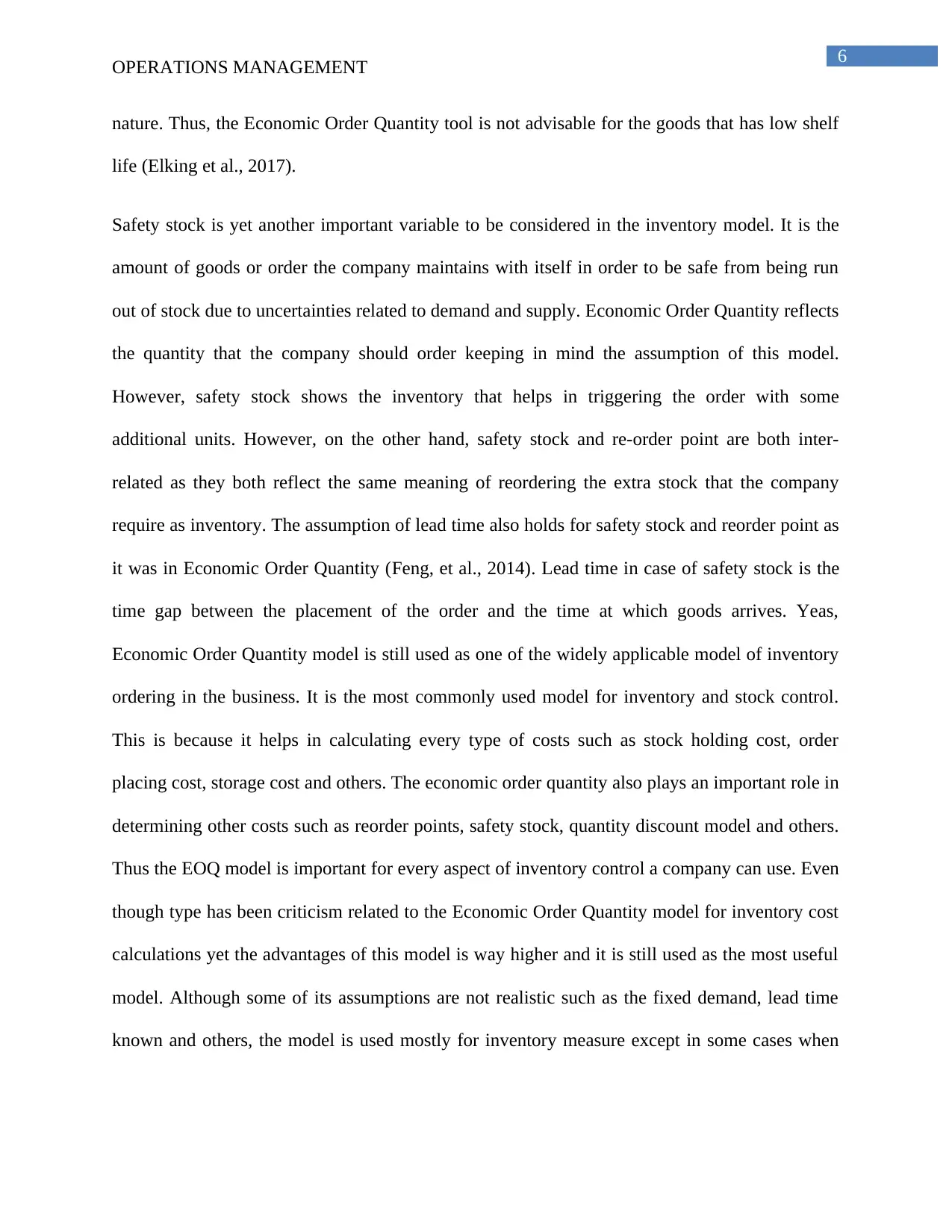
6
OPERATIONS MANAGEMENT
nature. Thus, the Economic Order Quantity tool is not advisable for the goods that has low shelf
life (Elking et al., 2017).
Safety stock is yet another important variable to be considered in the inventory model. It is the
amount of goods or order the company maintains with itself in order to be safe from being run
out of stock due to uncertainties related to demand and supply. Economic Order Quantity reflects
the quantity that the company should order keeping in mind the assumption of this model.
However, safety stock shows the inventory that helps in triggering the order with some
additional units. However, on the other hand, safety stock and re-order point are both inter-
related as they both reflect the same meaning of reordering the extra stock that the company
require as inventory. The assumption of lead time also holds for safety stock and reorder point as
it was in Economic Order Quantity (Feng, et al., 2014). Lead time in case of safety stock is the
time gap between the placement of the order and the time at which goods arrives. Yeas,
Economic Order Quantity model is still used as one of the widely applicable model of inventory
ordering in the business. It is the most commonly used model for inventory and stock control.
This is because it helps in calculating every type of costs such as stock holding cost, order
placing cost, storage cost and others. The economic order quantity also plays an important role in
determining other costs such as reorder points, safety stock, quantity discount model and others.
Thus the EOQ model is important for every aspect of inventory control a company can use. Even
though type has been criticism related to the Economic Order Quantity model for inventory cost
calculations yet the advantages of this model is way higher and it is still used as the most useful
model. Although some of its assumptions are not realistic such as the fixed demand, lead time
known and others, the model is used mostly for inventory measure except in some cases when
OPERATIONS MANAGEMENT
nature. Thus, the Economic Order Quantity tool is not advisable for the goods that has low shelf
life (Elking et al., 2017).
Safety stock is yet another important variable to be considered in the inventory model. It is the
amount of goods or order the company maintains with itself in order to be safe from being run
out of stock due to uncertainties related to demand and supply. Economic Order Quantity reflects
the quantity that the company should order keeping in mind the assumption of this model.
However, safety stock shows the inventory that helps in triggering the order with some
additional units. However, on the other hand, safety stock and re-order point are both inter-
related as they both reflect the same meaning of reordering the extra stock that the company
require as inventory. The assumption of lead time also holds for safety stock and reorder point as
it was in Economic Order Quantity (Feng, et al., 2014). Lead time in case of safety stock is the
time gap between the placement of the order and the time at which goods arrives. Yeas,
Economic Order Quantity model is still used as one of the widely applicable model of inventory
ordering in the business. It is the most commonly used model for inventory and stock control.
This is because it helps in calculating every type of costs such as stock holding cost, order
placing cost, storage cost and others. The economic order quantity also plays an important role in
determining other costs such as reorder points, safety stock, quantity discount model and others.
Thus the EOQ model is important for every aspect of inventory control a company can use. Even
though type has been criticism related to the Economic Order Quantity model for inventory cost
calculations yet the advantages of this model is way higher and it is still used as the most useful
model. Although some of its assumptions are not realistic such as the fixed demand, lead time
known and others, the model is used mostly for inventory measure except in some cases when
Paraphrase This Document
Need a fresh take? Get an instant paraphrase of this document with our AI Paraphraser

7
OPERATIONS MANAGEMENT
the demand fluctuates (Gupta& Iyengar, 2014). Thus EOQ is the ideal model for controlling and
reducing the cost of inventory at every level of the business.
Answer 3 (Section C)
Cost of inventory= $17,000 per day
Annual interest rate= 9 percent
Loan fees= $1,200 and 2.25 percent
The amount of loan Christie should borrow from the bank is $17,000 * 305 days
This stands to $51,85,000, which is the total amount of loan Christie will require for the annual
year
The bank currently charges 9 percent for the loan. Thus the total cost the company will bear for
the loan that it requires for an year is:
Annual ordering cost: 9% of $51,85,000
Annual ordering cost: 9/100* $51,85,000
This come to $4,66,650 is the amount or total cost the company will pay to the bank as a cost of
offering them the loan.
This is because the total cost of the company for the inventory is calculated by summing up the
annual ordering cost and annual carrying cost. However, in this case the carrying cost is zero as
the money is directly transferred by the bank as loan amount. Thus the total cost is equal to the
annual ordering cost (Hoberg et al., 2017).
OPERATIONS MANAGEMENT
the demand fluctuates (Gupta& Iyengar, 2014). Thus EOQ is the ideal model for controlling and
reducing the cost of inventory at every level of the business.
Answer 3 (Section C)
Cost of inventory= $17,000 per day
Annual interest rate= 9 percent
Loan fees= $1,200 and 2.25 percent
The amount of loan Christie should borrow from the bank is $17,000 * 305 days
This stands to $51,85,000, which is the total amount of loan Christie will require for the annual
year
The bank currently charges 9 percent for the loan. Thus the total cost the company will bear for
the loan that it requires for an year is:
Annual ordering cost: 9% of $51,85,000
Annual ordering cost: 9/100* $51,85,000
This come to $4,66,650 is the amount or total cost the company will pay to the bank as a cost of
offering them the loan.
This is because the total cost of the company for the inventory is calculated by summing up the
annual ordering cost and annual carrying cost. However, in this case the carrying cost is zero as
the money is directly transferred by the bank as loan amount. Thus the total cost is equal to the
annual ordering cost (Hoberg et al., 2017).
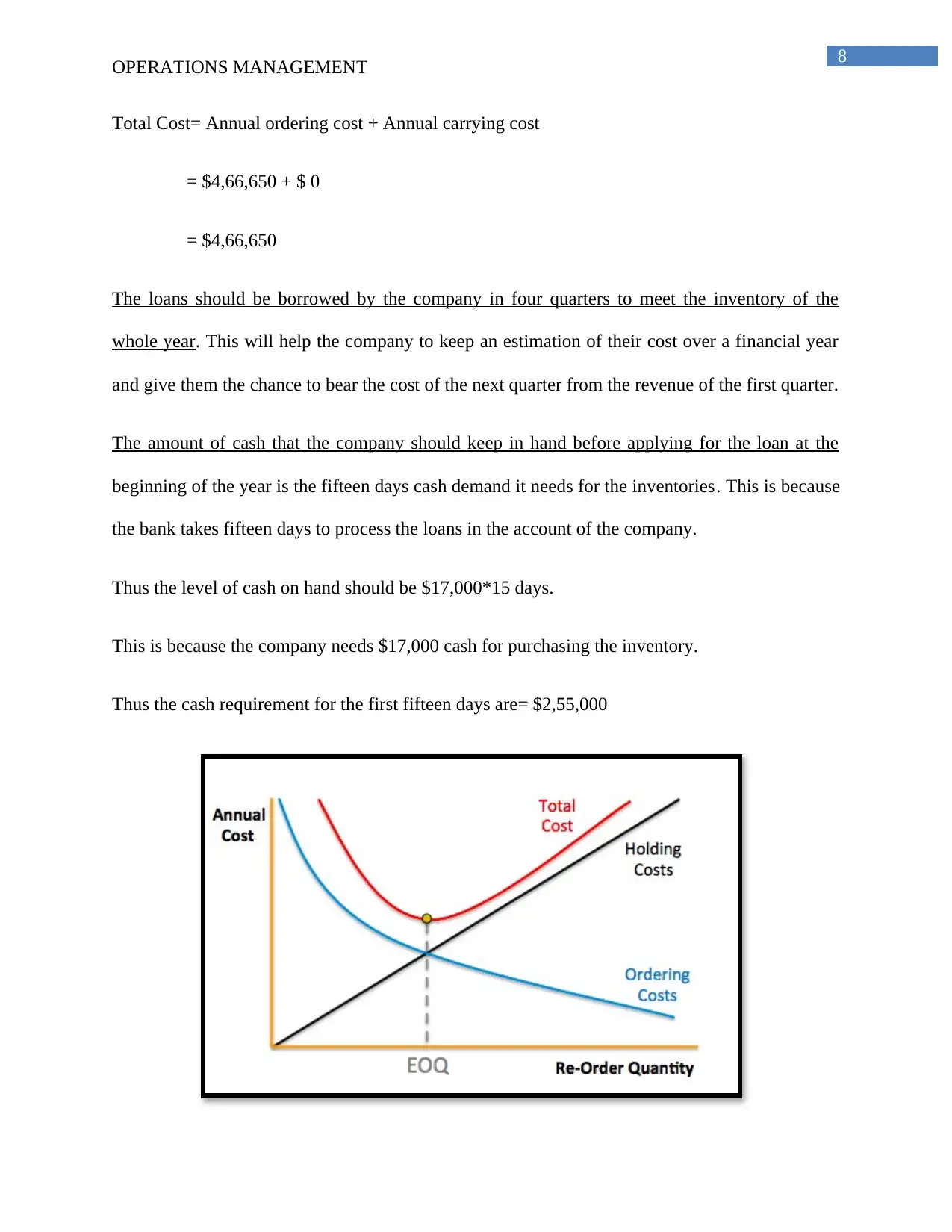
8
OPERATIONS MANAGEMENT
Total Cost= Annual ordering cost + Annual carrying cost
= $4,66,650 + $ 0
= $4,66,650
The loans should be borrowed by the company in four quarters to meet the inventory of the
whole year. This will help the company to keep an estimation of their cost over a financial year
and give them the chance to bear the cost of the next quarter from the revenue of the first quarter.
The amount of cash that the company should keep in hand before applying for the loan at the
beginning of the year is the fifteen days cash demand it needs for the inventories. This is because
the bank takes fifteen days to process the loans in the account of the company.
Thus the level of cash on hand should be $17,000*15 days.
This is because the company needs $17,000 cash for purchasing the inventory.
Thus the cash requirement for the first fifteen days are= $2,55,000
OPERATIONS MANAGEMENT
Total Cost= Annual ordering cost + Annual carrying cost
= $4,66,650 + $ 0
= $4,66,650
The loans should be borrowed by the company in four quarters to meet the inventory of the
whole year. This will help the company to keep an estimation of their cost over a financial year
and give them the chance to bear the cost of the next quarter from the revenue of the first quarter.
The amount of cash that the company should keep in hand before applying for the loan at the
beginning of the year is the fifteen days cash demand it needs for the inventories. This is because
the bank takes fifteen days to process the loans in the account of the company.
Thus the level of cash on hand should be $17,000*15 days.
This is because the company needs $17,000 cash for purchasing the inventory.
Thus the cash requirement for the first fifteen days are= $2,55,000
⊘ This is a preview!⊘
Do you want full access?
Subscribe today to unlock all pages.

Trusted by 1+ million students worldwide

9
OPERATIONS MANAGEMENT
Figure 1: Relationship between ordering cost, holding cost and total cost
Source: (Sarkar, Chaudhuri & Moon, 2015)
Q*= √2DS/H
In the following formula:
Q= optimal order quantity
D= units of annual demand
S= cost incurred to place a single order
H= carrying cost per order
This makes the total cost function as:
Total Cost= purchasing cost+ ordering cost + holding cost
In the economic order quantity the size of holding cost and ordering cost is minimized. Both
holding cost and ordering cost are inversely proportionate to each other as shown in the diagram.
An increase in one cost will cause a decrease in other as shown in the diagram above. It is seen
that as cost of holding is increasing continuously, the cost of ordering is decreasing. This is
because as the size of the order increases then the company is required to buy dew orders. This
causes a reduction in the number of order. This reduces the cost of order. On the other hand, the
holding space for bigger size of the order leads to an increase in cost. This increases the cost of
holding. Thus, this shows that holding cost and order8ng cost moves in a opposite direction. The
total of annual ordering cost and annual holding cost makes total cost of purchasing and holding
inventory (Sarkar, Chaudhuri & Moon, 2015).
OPERATIONS MANAGEMENT
Figure 1: Relationship between ordering cost, holding cost and total cost
Source: (Sarkar, Chaudhuri & Moon, 2015)
Q*= √2DS/H
In the following formula:
Q= optimal order quantity
D= units of annual demand
S= cost incurred to place a single order
H= carrying cost per order
This makes the total cost function as:
Total Cost= purchasing cost+ ordering cost + holding cost
In the economic order quantity the size of holding cost and ordering cost is minimized. Both
holding cost and ordering cost are inversely proportionate to each other as shown in the diagram.
An increase in one cost will cause a decrease in other as shown in the diagram above. It is seen
that as cost of holding is increasing continuously, the cost of ordering is decreasing. This is
because as the size of the order increases then the company is required to buy dew orders. This
causes a reduction in the number of order. This reduces the cost of order. On the other hand, the
holding space for bigger size of the order leads to an increase in cost. This increases the cost of
holding. Thus, this shows that holding cost and order8ng cost moves in a opposite direction. The
total of annual ordering cost and annual holding cost makes total cost of purchasing and holding
inventory (Sarkar, Chaudhuri & Moon, 2015).
Paraphrase This Document
Need a fresh take? Get an instant paraphrase of this document with our AI Paraphraser
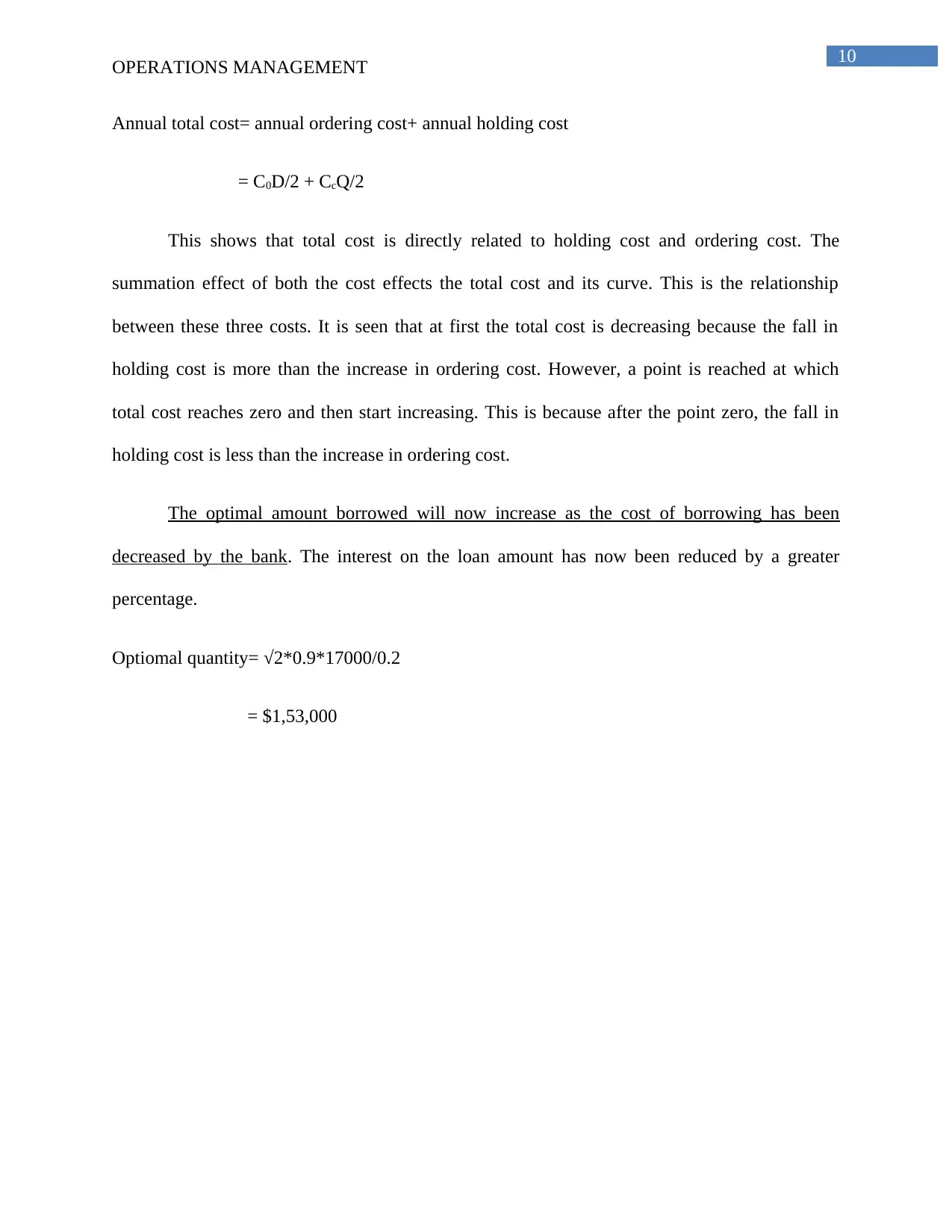
10
OPERATIONS MANAGEMENT
Annual total cost= annual ordering cost+ annual holding cost
= C0D/2 + CcQ/2
This shows that total cost is directly related to holding cost and ordering cost. The
summation effect of both the cost effects the total cost and its curve. This is the relationship
between these three costs. It is seen that at first the total cost is decreasing because the fall in
holding cost is more than the increase in ordering cost. However, a point is reached at which
total cost reaches zero and then start increasing. This is because after the point zero, the fall in
holding cost is less than the increase in ordering cost.
The optimal amount borrowed will now increase as the cost of borrowing has been
decreased by the bank. The interest on the loan amount has now been reduced by a greater
percentage.
Optiomal quantity= √2*0.9*17000/0.2
= $1,53,000
OPERATIONS MANAGEMENT
Annual total cost= annual ordering cost+ annual holding cost
= C0D/2 + CcQ/2
This shows that total cost is directly related to holding cost and ordering cost. The
summation effect of both the cost effects the total cost and its curve. This is the relationship
between these three costs. It is seen that at first the total cost is decreasing because the fall in
holding cost is more than the increase in ordering cost. However, a point is reached at which
total cost reaches zero and then start increasing. This is because after the point zero, the fall in
holding cost is less than the increase in ordering cost.
The optimal amount borrowed will now increase as the cost of borrowing has been
decreased by the bank. The interest on the loan amount has now been reduced by a greater
percentage.
Optiomal quantity= √2*0.9*17000/0.2
= $1,53,000
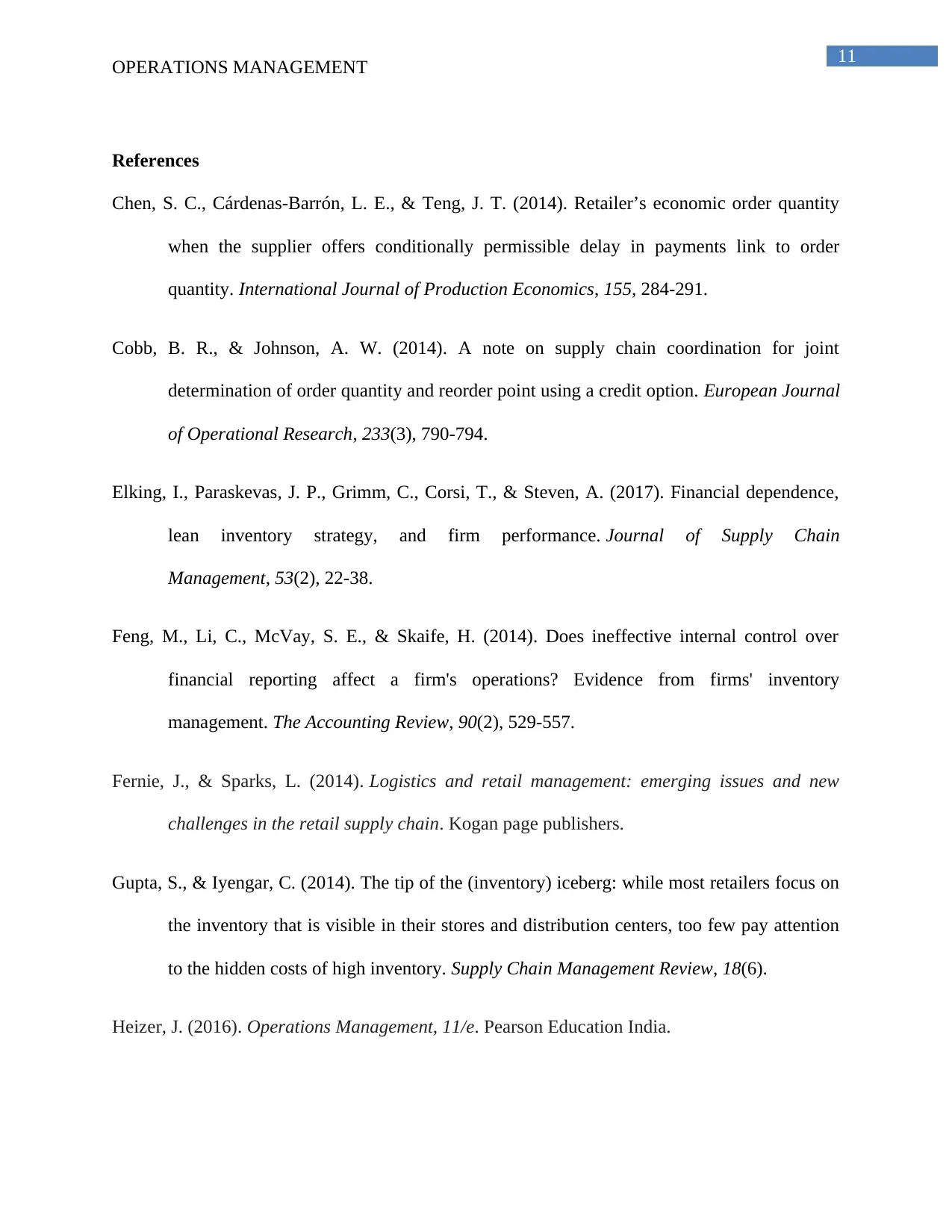
11
OPERATIONS MANAGEMENT
References
Chen, S. C., Cárdenas-Barrón, L. E., & Teng, J. T. (2014). Retailer’s economic order quantity
when the supplier offers conditionally permissible delay in payments link to order
quantity. International Journal of Production Economics, 155, 284-291.
Cobb, B. R., & Johnson, A. W. (2014). A note on supply chain coordination for joint
determination of order quantity and reorder point using a credit option. European Journal
of Operational Research, 233(3), 790-794.
Elking, I., Paraskevas, J. P., Grimm, C., Corsi, T., & Steven, A. (2017). Financial dependence,
lean inventory strategy, and firm performance. Journal of Supply Chain
Management, 53(2), 22-38.
Feng, M., Li, C., McVay, S. E., & Skaife, H. (2014). Does ineffective internal control over
financial reporting affect a firm's operations? Evidence from firms' inventory
management. The Accounting Review, 90(2), 529-557.
Fernie, J., & Sparks, L. (2014). Logistics and retail management: emerging issues and new
challenges in the retail supply chain. Kogan page publishers.
Gupta, S., & Iyengar, C. (2014). The tip of the (inventory) iceberg: while most retailers focus on
the inventory that is visible in their stores and distribution centers, too few pay attention
to the hidden costs of high inventory. Supply Chain Management Review, 18(6).
Heizer, J. (2016). Operations Management, 11/e. Pearson Education India.
OPERATIONS MANAGEMENT
References
Chen, S. C., Cárdenas-Barrón, L. E., & Teng, J. T. (2014). Retailer’s economic order quantity
when the supplier offers conditionally permissible delay in payments link to order
quantity. International Journal of Production Economics, 155, 284-291.
Cobb, B. R., & Johnson, A. W. (2014). A note on supply chain coordination for joint
determination of order quantity and reorder point using a credit option. European Journal
of Operational Research, 233(3), 790-794.
Elking, I., Paraskevas, J. P., Grimm, C., Corsi, T., & Steven, A. (2017). Financial dependence,
lean inventory strategy, and firm performance. Journal of Supply Chain
Management, 53(2), 22-38.
Feng, M., Li, C., McVay, S. E., & Skaife, H. (2014). Does ineffective internal control over
financial reporting affect a firm's operations? Evidence from firms' inventory
management. The Accounting Review, 90(2), 529-557.
Fernie, J., & Sparks, L. (2014). Logistics and retail management: emerging issues and new
challenges in the retail supply chain. Kogan page publishers.
Gupta, S., & Iyengar, C. (2014). The tip of the (inventory) iceberg: while most retailers focus on
the inventory that is visible in their stores and distribution centers, too few pay attention
to the hidden costs of high inventory. Supply Chain Management Review, 18(6).
Heizer, J. (2016). Operations Management, 11/e. Pearson Education India.
⊘ This is a preview!⊘
Do you want full access?
Subscribe today to unlock all pages.

Trusted by 1+ million students worldwide
1 out of 13
Related Documents
Your All-in-One AI-Powered Toolkit for Academic Success.
+13062052269
info@desklib.com
Available 24*7 on WhatsApp / Email
![[object Object]](/_next/static/media/star-bottom.7253800d.svg)
Unlock your academic potential
Copyright © 2020–2025 A2Z Services. All Rights Reserved. Developed and managed by ZUCOL.




